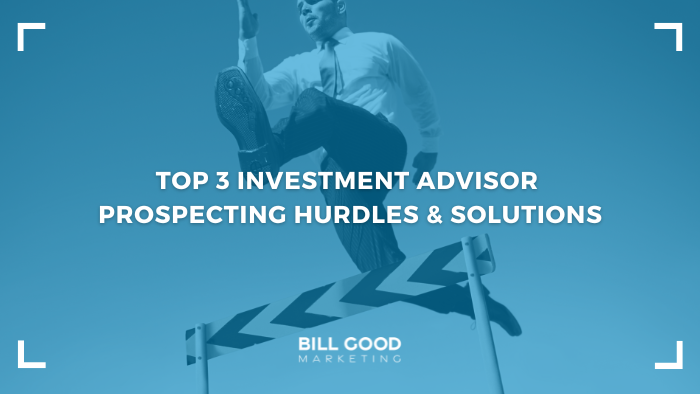
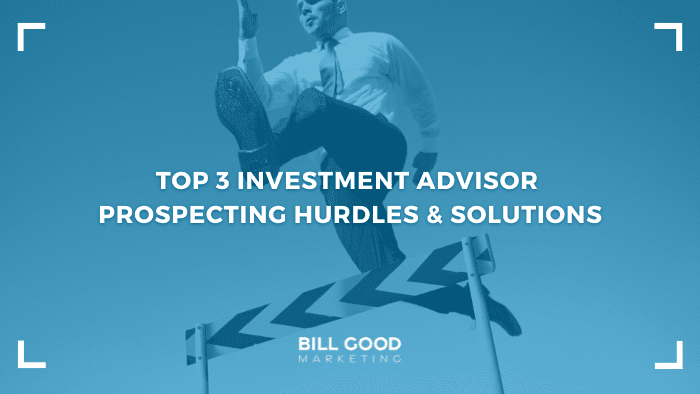
Top 3 Investment Advisor Prospecting Hurdles & Solutions
Presumably, you are reading this article because you’re interested in financial advisor prospecting. So, before we do anything else, let’s define what prospecting actually is.
The original version of this story was published on ThinkAdvisor®
The greatest prospecting opportunity in the history of this industry is right now.
No, it’s not cold calling.
It’s not the “85% of high net worth investors who would consider changing advisors or be open to a second opinion.”
It’s not networking, referrals, introductions, seminars, direct mail, or anything else.
It’s the legions of baby boomer brokers who, like their counterparts in the society at large are inevitably, if reluctantly, lumbering toward retirement.
If you are thirty-five to fifty or so, you should seriously think about a partnership with a senior advisor, with the long-term objective of buying him or her out.

A few days before writing this article, I received this email from a client.
Recently, a senior Investment Advisor in my office took me out for lunch to discuss the long-term possibility of my buying his book/becoming his partner. He appears to be in the early stages of his succession planning, but apparently I am on his radar as a candidate to take over for him. He is thinking of working perhaps as much as ten years. I wanted to share this with you to see if you have any insights as to how I should approach this opportunity going forward, and to make sure I stay top of mind.
I replied:
The average age of a financial advisor today is about 58. Just look around at any meeting you attend.
The flip side of this is the much smaller number of younger advisors. In the next decade, billions if not trillions in assets will go in play as senior advisors retire or pass away. Younger advisors, now in the industry, have the most golden opportunity of any group, probably since the early baby boomers hit the markets in 1983, 1984, 1985.
With that said, I encourage you to continue these discussions. You should have these discussions with several others. Please understand—you are in high demand. There are more of them than there are of you. Pick the best opportunity.
What is the best opportunity?
It’s not necessarily the oldest and richest. Personality conflicts could intervene. The oldest and richest might have clients who will pass away even before the FA retires.
The best opportunity is with someone you like and trust. He or she has at least $50 million in AUM, and is willing to completely share knowledge and skill. Ideally, it is someone whose book contains a substantial percentage of people younger than the FA.
Probably the best way to find out if a particular partnership will work, is go through the steps of my “Partnership Process.” These steps are scattered in my “Partnership” white paper,” a collection of articles I’ve written about partnerships over twenty plus years. Not to toot my own horn (toot toot), but in 1989, I wrote, “As we move into the 1990s, I firmly believe that small advisor organizations, operating within the framework of larger companies, will become the wave of the future. I believe that the $250,000 producer operating with one-eighth of an assistant will survive as an entry-level position only. People will come into the industry, and when they have proven they can sell and deal with clients, they’ll have two choices: develop their own organization, or develop a partnership complete with support staff.”
Oh, at the time I wrote this, the official position in many firms was: “Partnerships are worse than marriages. Don’t go there.”


There are at least five types of successful partnership models. These are covered in “Partnerships.”
The “Senior/Junior” is the one that applies. I am now re-naming this “The Buyout Partnership” because its purpose is: ensure client relationships created over a business lifetime are properly cared for. An apparent option is: sell the business and step aside. Under certain conditions, such as disability or failing health, this is the only way to go. But for an FA who wishes to ensure continuity in advice and service, the “Buyout Partnership” is the way to go.


This is really just a common-sense series of steps. Some of these steps are preventative medicine for partnership failure. How many times have I seen partnerships fly apart because of differences in work ethics leading to real or perceived injustice?
So here we go:
For the senior, this means find someone at least 15, preferably 20, years younger. For the junior, vice versa. This can be as simple as letting your complex manager know you are looking. You can, and probably should, join a local group, such as an FPA chapter. An even more radical approach, search Google® and look at pictures of FAs. I’ve added some tips in “Buyout Partnerships” on how to do that. I have also added some resources on buying a practice.
The basis for a surviving partnership is enduring friendship and goodwill, and common ground on investment strategy. Perhaps like most surviving marriages, a long courtship is worthwhile.
Obviously, you need to agree on investment philosophy. A partnership MUST speak with one voice. At the time the relationship comes together, that voice is the senior partner’s.
For other types of partnerships, the partners need a similar work ethic. However, in the “Buyout Partnership,” part of the agreement can be for the senior partner to work less and the junior partner more. It’s sort of a “your brawn, my brains” deal.
A warning: sometimes when I talk to a partner from a dissolved partnership, I ask, “When did you start getting second thoughts?” Frequently the answer is, “Right from the start.” My suggestion: listen to your second thoughts. If they persist, make them first thoughts, and start over. Better to start over before the partnership launches than some years later.
There are really two steps to arrive at an agreement. You must have the proverbial “meeting of the minds,” and you must get it in writing.
Here are some of the items you must address.
Gather data. Each prospective partner should be willing to share some data about clients. These data do not have to disclose client names, but they should include the following information: Assets, Revenue, Dates of Birth, and known health issues. At my Partnerships website, I have a spreadsheet for you. Among other things, it will calculate average age for client and spouse. In my “Buyout Partnership” white paper, I have instructions on how to calculate the life expectancy of that book.
Consider: Suppose the average age of a clientele is: husband 76 and wife 72. Very roughly, in ten years, 20% of both spouses will have passed away. Unless you have drilled deep into the family relationship, 20% or more of your assets will have gone to the heirs to be spent or managed elsewhere. If you have 300 clients now, in ten years, you will have 240. Therefore, just to stay even, you need to add a minimum of six households per year. And this doesn’t even factor in losses due to withdrawal. If you are really brave, you will fill in the withdrawal cell on my spreadsheet. As a matter of fact, anyone with a book of retirees should download the “Buyout Partnership” and learn how to get a rough idea of the life expectancy of your book.
Get an appraisal. This is vital. A senior partner’s business with $50 million in assets could be worth less than a junior partner’s business with $25 million, assuming the junior is fee-based. I have some resources for you in the “The Buyout Partnership.”
Decide to become a partnership. A partnership, by definition, is “a business entity in which the partners share with each other the profits or losses of the business.” I suppose you could say that a partnership could consist of “these are mine/those are yours/and these are ours.” You could say that. But that does not make it so. I have seen the “mine/yours/ours” model tried countless times, but they blow up sooner rather than later.
There are at least two reasons for their demise: lack of trust and “ours” become orphans. If you had complete trust in your partners, you would throw it all in one bucket. The problem with “ours” is that each partner can always make more by working on “his” or “hers.” “Ours” gets neglected. My counsel is: keep talking until you trust your partner enough to put all the clients in one bucket. This means no trial marriages. Get married or break up. No living together!
Negotiate initial compensation. There is no hard and fast rule on this. Probably the most frequent initial comp formula is: add trailing 12 gross revenue for each partner to get a total. Each partner gets their percentage of the whole.
Negotiate compensation trend. Unless the senior partner’s departure is imminent, a partnership with long-term survival value must trend toward 50-50. Let’s say that the senior partner’s production is $500K and the junior is $250. Initially, the senior partner draws compensation of 2/3 and the junior 1/3. But if the junior partner starts finding new assets from existing clients and bringing in new clients, production will go up. So the junior partner should, over a several year period, step to a 50-50% split. Let’s say at $1 million, the percentages are 60-40. The senior is actually making more but has a lower percentage. A series of steps such as this can be calculated.
Work out a decision-making process. One of the biggest dangers of a partnership is: “cannot make a decision.” Two 50-50 partners disagree and forward motion stops. I suggest if a decision cannot be made, a person respected by both is brought in to break the tie.
Decide how to handle disability. I am familiar with one partnership where one of the partners was ill for a year. The other partners carried on, kept the business alive and kept sending the checks. But suppose it’s five years? Stuff happens.
Decide on a divorce clause. One of the big reasons partnerships break up is because the partners never looked at what could happen and planned for it.
Suppose one partner wants to change firms and the other does not?
Suppose one partner develops a different investment philosophy?
The possibilities are endless.
A possible provision in your agreement could be something like: Each partner is entitled to take clients he or she brought to the partnership. A meeting will be held with a mutually agreed on mediator to apportion the other clients on the basis of revenue and relationship with the understanding that the split on revenue shall be approximately the split on income as specified elsewhere in this agreement.
The better job you do deciding how to split the less likely you are to split.
You are two years down the road, and one of the partners tells the other, “But I thought you meant … !” You must avoid this by getting your agreement in writing.
I recommend the partners work out between them what they agree to. Maybe you will have some sticking points, but table them. Develop your own agreements. Write them down. And then consult an attorney. The type of attorney you are looking for is probably someone in a small law firm. This partnership model is the same model as a small law firm. I also urge you to get one attorney to act as counsel to the partnership. He or she will undoubtedly bring ideas and viewpoints that you have not yet considered. At the very end, you can each consult your own attorney, but please, if possible, don’t each hire a separate attorney. Legal bills will be many times what they would otherwise be.


“The Buyout Partnership” is the pot of gold at the end of the Baby Boomer rainbow. The senior partner monetizes the practice. The junior FA steps into a big business.


Bill Good is the founder and chairman of Bill Good Marketing. His latest book, “Hot Prospects,” is No. 88 on the 96 Best Prospecting Books of All Time list and is available on Amazon. He created the Bill Good Marketing System and has been named one of the industry’s top five coaches.


Presumably, you are reading this article because you’re interested in financial advisor prospecting. So, before we do anything else, let’s define what prospecting actually is.
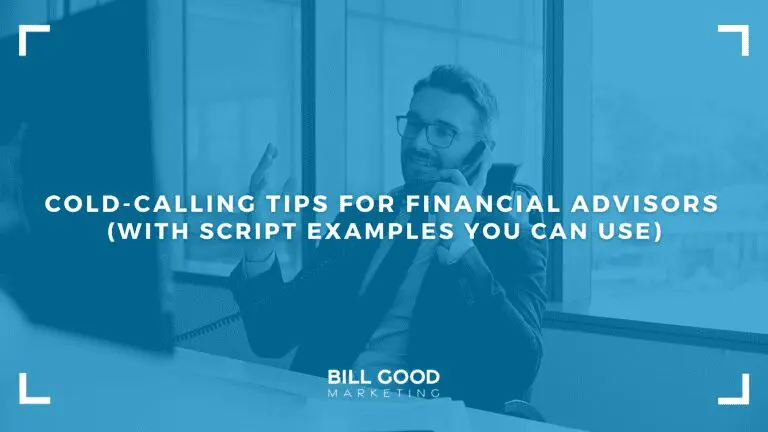
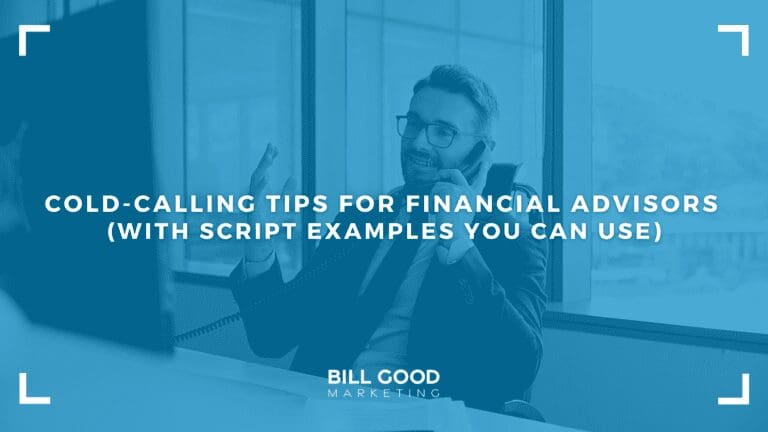
Cold-calling is NOT a “try it once and hope it works” endeavor. It requires testing and tweaking to learn what works for your market, your list, and for you. Cold-calling is NOT for advisors who fear rejection. You will get a lot of rejections when you cold call – but if you follow best practices, it won’t matter, because the number of new leads you…
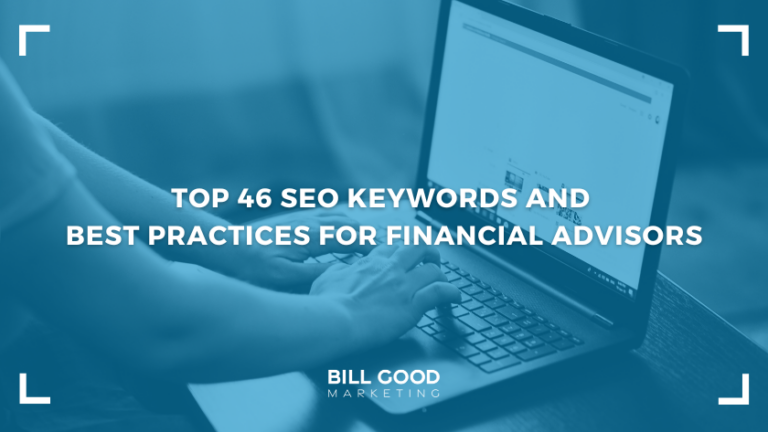
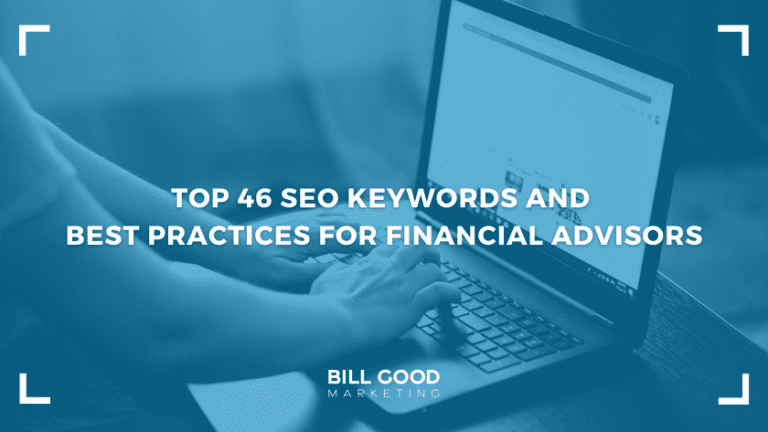
Staying on top of the best keywords for your business is essential for effective SEO. As we’ve discussed, these keywords help connect your website with the people who are searching for the services you offer. Based on insights from Google’s Keyword Planner, here are the 46 most relevant keywords for financial advisors…
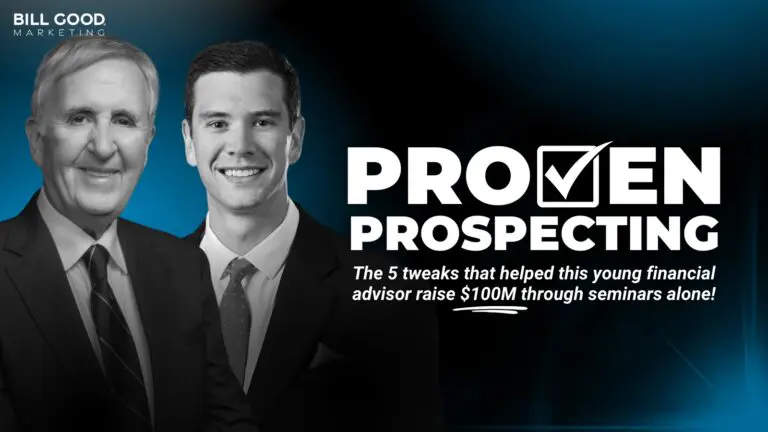

When Neil McPeak Jr. — CFP®, CEPA® — joined his father’s practice fresh out of college, he was given one instruction: Learn to prospect. In other words, want to manage your own assets? Go out and find them yourself. (That wasn’t on his college curriculum…
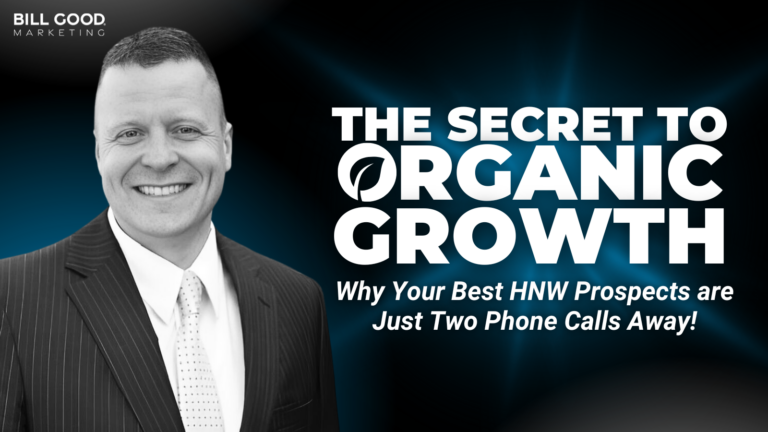
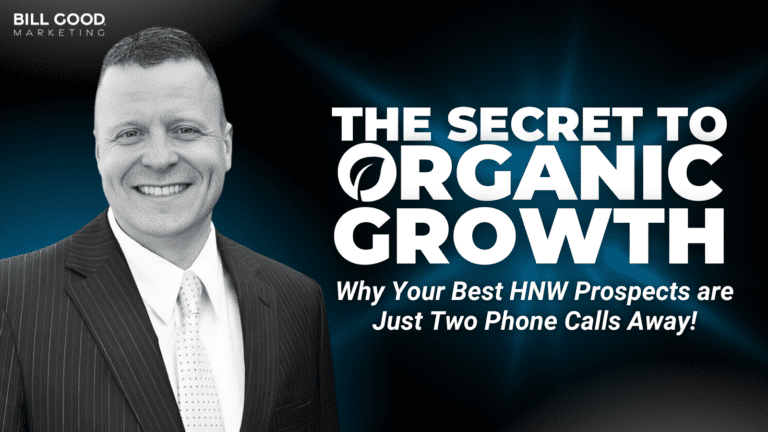
HNW clients. You want ‘em. Everyone wants them. And you’ve likely gotten a dozen emails this month alone on how easy it can be to get more. But whether you’ve been in this industry for 1 year or 30, you know the truth…
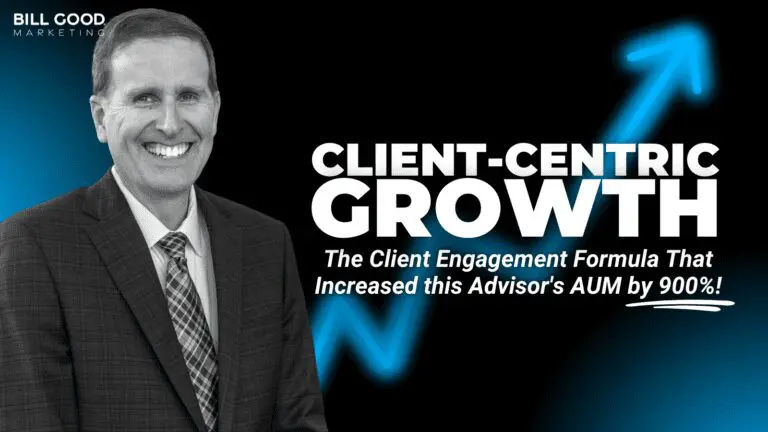
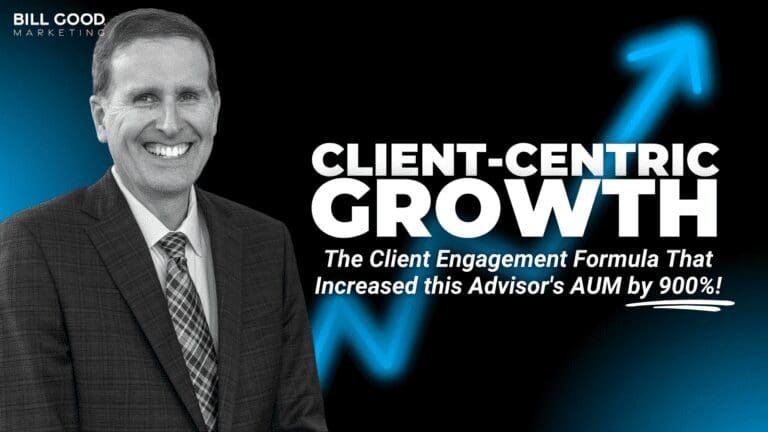
Are you ready to unlock the formula that skyrocketed a Texas advisor’s AUM by 900%? Join us for an exclusive, one-time webinar revealing the strategies Mark Trice used to transform his $14M practice into a $134.4M business…